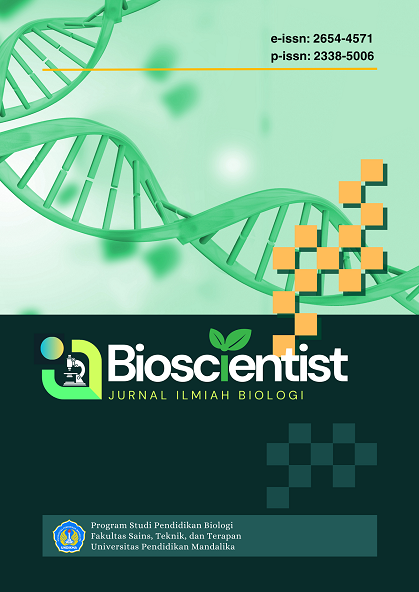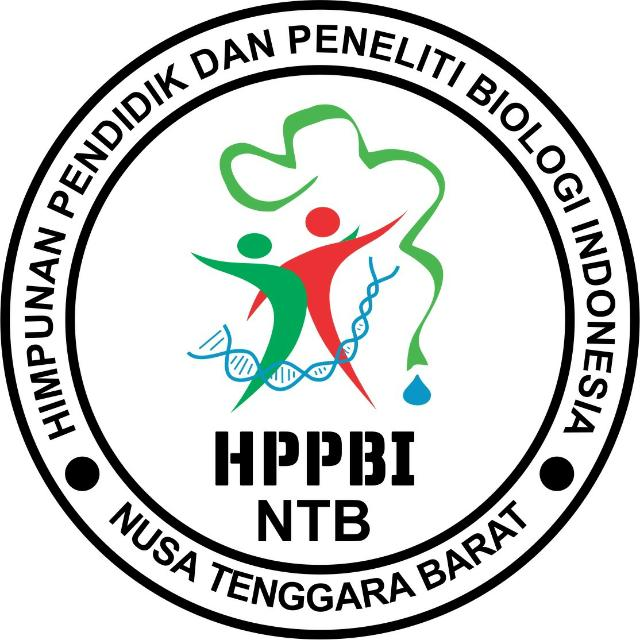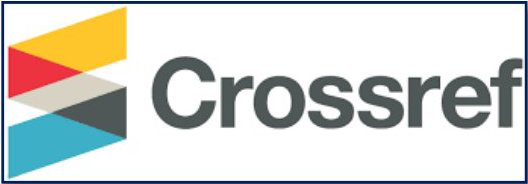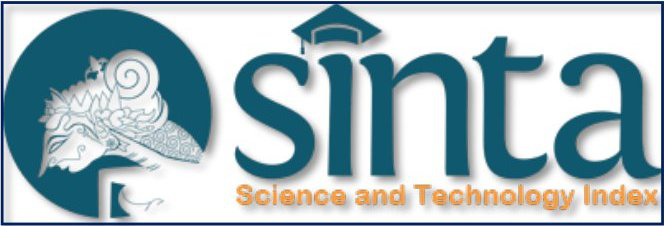Potensi Metabolit Sekunder Tanaman Syzygium sp. Terhadap LOX-1 Sebagai Target Terapi Penyakit Aterosklerosis: Studi In Silico
DOI:
https://doi.org/10.33394/bioscientist.v13i1.14817Keywords:
aterosklerosis, in silico, LOX-1, metabolit sekunder, SyzygiumAbstract
Atherosclerosis is a cardiovascular disease characterized by the accumulation of oxidized lipoproteins in the arterial wall, which is triggered by LOX-1 receptor activation. The members of Syzygium genus contains secondary metabolites with antioxidant and anti-inflammatory activities that have the potential to inhibit LOX-1. This study aims to evaluate the interaction of compounds from Syzygium cumini, Syzygium aromaticum, Syzygium malaccense, and Syzygium jambos against LOX-1 using in silico method. Analysis was conducted through molecular docking, pharmacophore selection based on hydrophobic and hydrogen bond interaction criteria, and validation using Root Mean Square Deviation (RMSD ≤ 3 Å) values. The research results showed that gallic acid has the highest affinity (-4.1 kcal/mol), followed by linalool (-3.8 kcal/mol), kaempferol (-3.4 kcal/mol), oxalic acid (-3.4 kcal/mol), quercetin (-2.2 kcal/mol), and myricetin (-1.4 kcal/mol). The compounds with the highest affinity interacted with key LOX-1 residues, suggesting potential inhibition of the receptor. In conclusion, gallic acid is the most potent LOX-1 inhibitor candidate based on its stable interaction and highest affinity value. Further studies are needed to confirm its biological activity through in vitro and in vivo approaches.
References
Astutik, P., Yuswantina, R., & Vifta, R. L. (2021). Perbandingan Aktivitas Antifungi Ekstrak Etanol 70% Dan 96% Buah Parijoto (Medinilla speciosa) Terhadap Candida albicans. Journal of Holistics and Health Science, 3(1), 32–41. doi:https://doi.org/10.35473/jhhs.v3i1.66
Candra, G. N. H., & Wijaya, I. M. A. P. (2021). Molecular Docking Kaempferol sebagai Antiinflamasi pada Aterosklerosis secara In Silico. Jurnal Ilmiah Medicamento, 7(1), 13–18. doi:https://doi.org/10.36733/medicamento.v7i1.1497
Chagas, V. T., França, L. M., Malik, S., & Paes, A. M. de A. (2015). Syzygium cumini (L.) skeels: A Prominent Source of Bioactive Molecules Against Cardiometabolic Diseases. Frontiers in Pharmacology, 6. doi:https://doi.org/10.3389/fphar.2015.00259
Erlund, I. (2004). Review of The Flavonoids Quercetin, Hesperetin, and Naringenin. Dietary Sources, Bioactivities, Bioavailability, and Epidemiology. Nutrition Research, 24(10), 851–874. doi:https://doi.org/10.1016/j.nutres.2004.07.005
Evary, Y. M., Djide, N. J. N., & Aulia, I. N. (2024). Discovery of Active Antibacterial Fractions of Different Plant Part Extracts of clove (Syzigium aromaticum) Against Streptococcus mutans. Journal of Experimental Biology and Agricultural Sciences, 12(4), 625–633. https://doi.org/10.18006/2024.
Hasiholan, M. (2020). Penerapan Metode Log (Laplacian Of Gaussian) Dalam Mendeteksi Tepi Citra Pada Penyakit Aterosklerosis. Jurnal Pelita Informatika, 8(4).
Huang, W., Hutabarat, R. P., Chai, Z., Zheng, T., Zhang, W., & Li, D. (2020). Antioxidant Blueberry Anthocyanins Induce Vasodilation via PI3K/Akt Signaling Pathway in High-Glucose-Induced Human Umbilical Vein Endothelial Cells. International Journal of Molecular Sciences, 21(5), 1575. doi:https://doi.org/10.3390/ijms21051575
Johns, A. E., & Radhamany, P. M. (2024). Phytochemical Screening, HPTLC and FT-IR analysis of Methanolic Bark Extract of Syzygium stocksii (Duthie)Gamble- a critically endangered taxon in Myrtaceae. International Journal of Biology and Chemistry, 17(2), 158–166. https://doi.org/10.26577/ijbch2024v17.i2.13
Kattoor, A. J., Goel, A., & Mehta, J. L. (2019). LOX-1: Regulation, Signaling and Its Role in Atherosclerosis. Antioxidants, 8(7), 218. doi:https://doi.org/10.3390/antiox8070218
Kusumorini, A., Suryani, Y., Ayuni, F. Q., & Taupiqurrohman, O. (2024). In-Silico Analysis of Eugenol and Beta-Caryophyllene Compounds in Clove (Syzygium aromaticum L.) on NF-kB Protein As Anti-inflammatory Agent In Atherosclerosis. Elkawnie, 10(1), 88. doi:https://doi.org/10.22373/ekw.v10i1.17387
Lee, W.-J., Ou, H.-C., Hsu, W.-C., Chou, M.-M., Tseng, J.-J., Hsu, S.-L., Tsai, K.-L., & Sheu, W. H.-H. (2010). Ellagic Acid Inhibits Oxidized LDL-mediated LOX-1 Expression, ROS Generation, and Inflammation in Human Endothelial Cells. Journal of Vascular Surgery, 52(5), 1290–1300. doi:https://doi.org/10.1016/j.jvs.2010.04.085
Li, R. L., Wang, L. Y., Liu, S., Duan, H. X., Zhang, Q., Zhang, T., Peng, W., Huang, Y., & Wu, C. (2022). Natural Flavonoids Derived From Fruits Are Potential Agents Against Atherosclerosis. In Frontiers in Nutrition, 9. doi:https://doi.org/10.3389/fnut.2022.862277
Makisake, R. G., Montolalu, R. I., Mewengkang, H. W., Sanger, G., Harikedua, S. D., Makapedua, D. M., Salindeho, N., Zagoto, E. B. S., & Gumolung, I. J. P. A. (2022). Studi In Silico Senyawa Aktif Daun Tagalolo (Ficus Septica Burm F) Sebagai Ligan Uji Pada Enzim L-Histidin Decarboxylase. Media Teknologi Hasil Perikanan, 10(2), 122–126. doi:https://doi.org/10.35800/mthp.10.2.2022.40390
Nur, A. V., Slamet, Waznah, U., Mugiyanto, E., & Pambudi, D. B. (2024). Molecular Docking Metabolit Sekunder Bawang Putih (Allium Sativum) sebagai Antikanker Payudara: Pendekatan In-Silico. In Journal of Integrative Natural Science 2024, 1(1). https://ejournal.unsika.ac.id/index.php/JoINS
Ochieng, M. A., ben Bakrim, W., Bitchagno, G. T. M., Mahmoud, M. F., & Sobeh, M. (2022). Syzygium jambos L. Alston: An Insight Into its Phytochemistry, Traditional Uses, and Pharmacological Properties. Frontiers in Pharmacology, 13. doi:https://doi.org/10.3389/fphar.2022.786712
Rokom. (2023, October 25). Cegah Penyakit Jantung dengan Menerapkan Perilaku CERDIK dan PATUH. Kementerian Kesehatan RI.
Syauqy, A., Rahman, A. O., & Purwakanthi, A. (2020). Pemeriksaan Kadar Kolesterol Darah Pada Masyarakat Umum Saat Car Free Day di Lapangan Gubernur Kota Jambi Sebagai Skrining Awal Hiperkolesterolemia. Medical Dedication (Medic) : Jurnal Pengabdian Kepada Masyarakat FKIK UNJA, 3(1), 18–21. doi:https://doi.org/10.22437/medicaldedication.v3i1.8580













